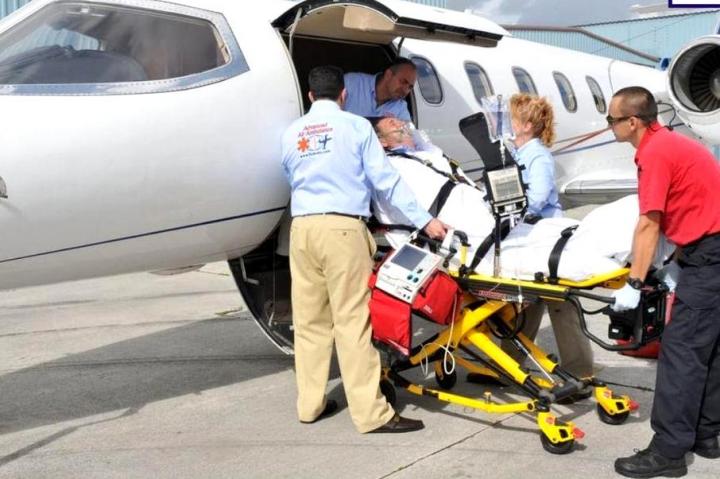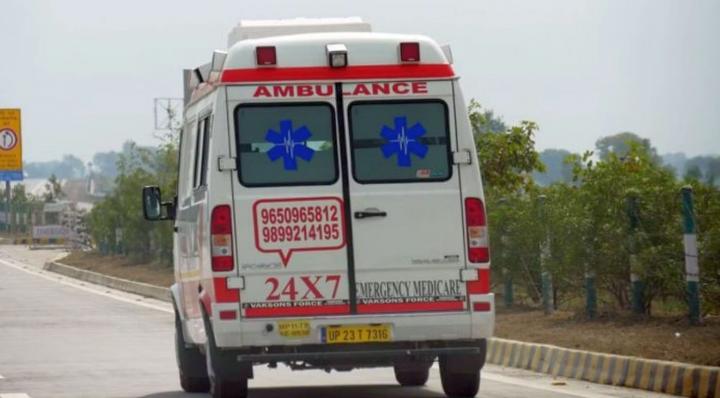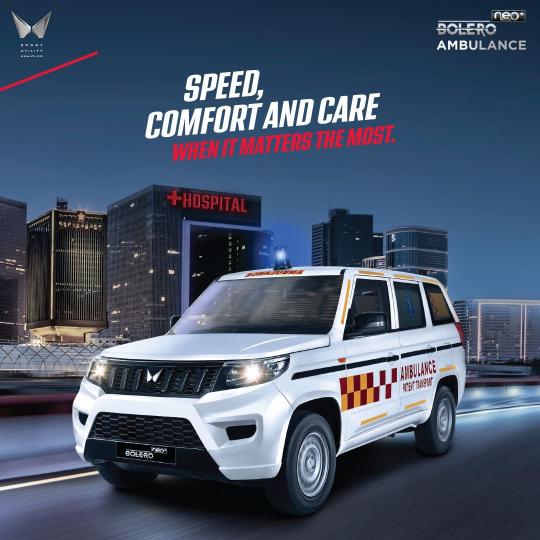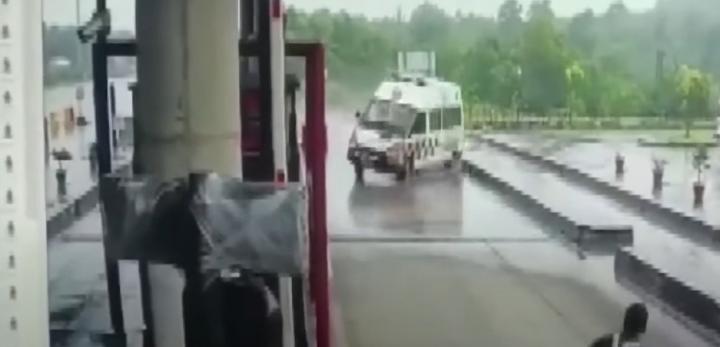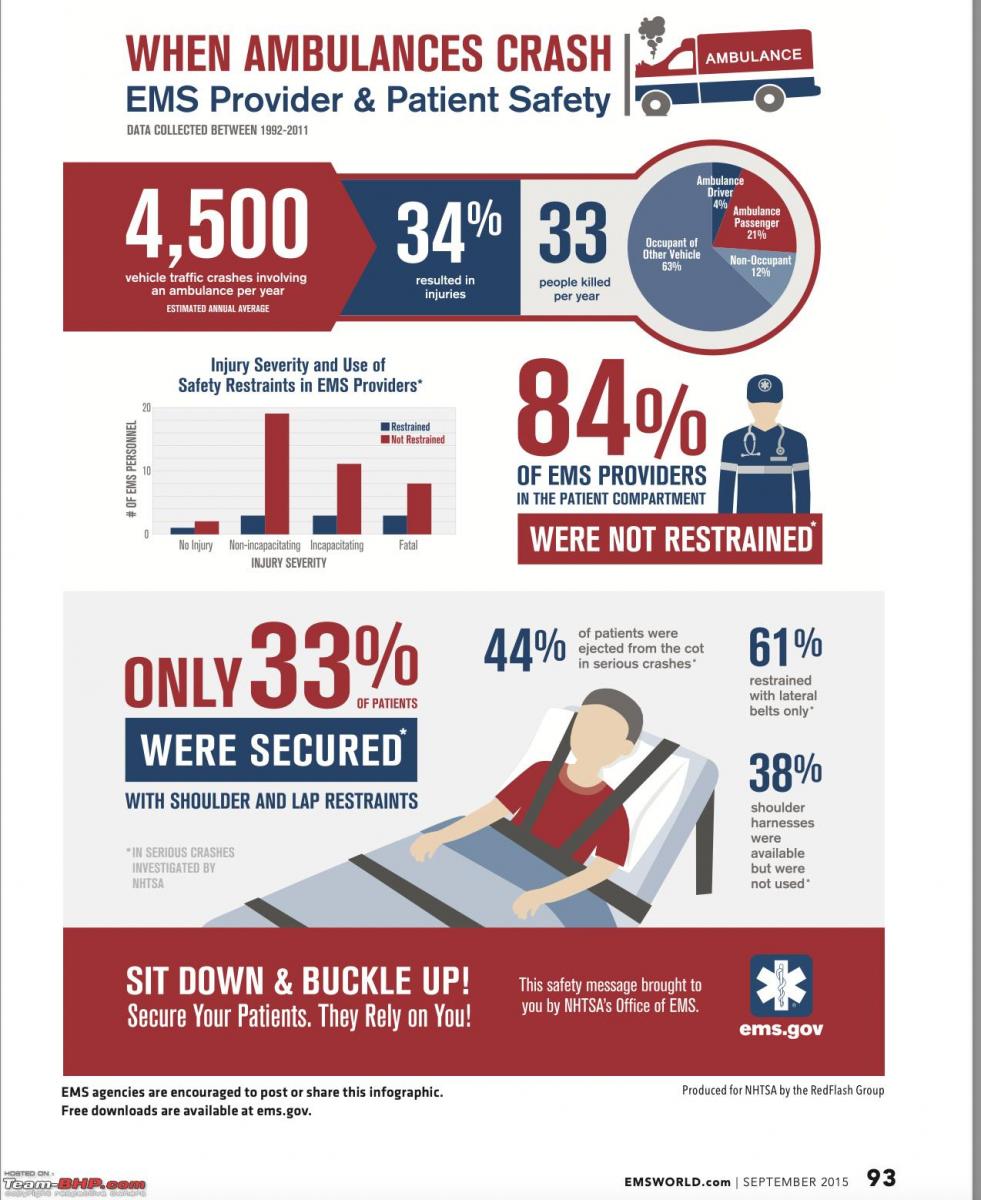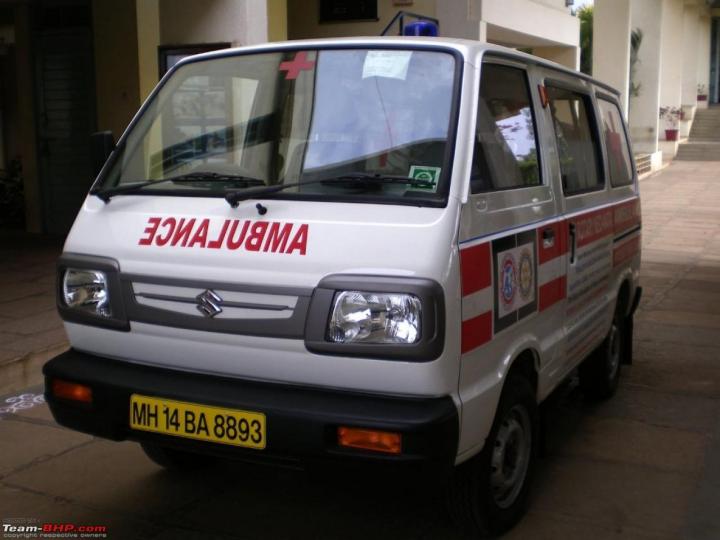News
Used an air ambulance service in India: Things could have been better
Full payment was taken upfront. The aircraft assigned to us had a very narrow fuselage. 2 seats were removed to make space for the patient's stretcher & secure it.
BHPian BlackBeard recently shared this with other enthusiasts.
Hello Everybody,
This is to narrate my experience of utilizing the services of an Air Ambulance in India. The trip was from CCU to MAA.
In 2022, a family member was diagnosed with a brain tumor, the MRI scan showed it to be sizeable and on a 2nd opinion from a known surgeon in Chennai, he recommended immediate surgery.
As the patient was stretcher bound we looked for commercial flight options.
Apparently, only Indigo & Air India transport stretcher-bound patients by air. To obtain the necessary permissions and get a slot on a flight (3 rows of seats have to be removed i.e 9 Pax. to accommodate a stretcher) is very time-consuming (Minimum 3-7 days) & depending on the passenger traffic in that particular sector further delays can occur, no doubt it's cheaper than the air ambulance.
We decided the faster & better option would be to take an Air Ambulance. I searched the internet for options (Most air ambulance operators are located in Mumbai or New Delhi) & asked around a few friends and the hospital itself & got a few leads.
After shortlisting a few operators I sent enquiries regarding the charges for the transportation, type of aircraft, facilities provided, how many support staff & family members were allowed to accompany the patient, etc.
Since time was of the essence we shortlisted an air ambulance service provider based out in Mumbai. The aircraft assigned to us was a 6 seater Beechcraft Kingair C90 of 1980s/1990s vintage LMW Coimbatore was an ex-owner.
Full payment was taken upfront and further details were shared only after that. 1 doctor, 1 nurse/technician & some medical eqpt. were provided (Ventilator, multipara monitor, defibrillator, suction machine, Oxygen etc).
We thankfully did not need any of the eqpt. 2 family members were allowed on board the flight. We were told ETA of the aircraft at CCU was 1900 Hrs.
The Ambulance arrived late at the hospital to pick us up. The journey from the hospital to the airport was by ambulance paid for by us and arranged by them (the vehicle was a Tata Winger). The driver was a slightly better version of the Ola/Uber chaps we use, sudden braking and all over the road (luckily the patient's stretcher was strapped down, myself & another family member was all over the place. I guess in India the concept of giving emergency vehicles the right of way is still alien to most people on the road.
Once we reached the airport, we dropped off the lady passenger at the domestic departure terminal for boarding formalities and alighted the ambulance waiting for the AAI ambulance to take us to the Apron. The patient's stretcher was offloaded on the tarmac.
There is something fundamentally wrong with us Indians, the absolute lack of empathy or conducting ourselves in a dignified manner. Making an 80-year-old man awaiting a medevac lie in a stretcher on the tarmac of a busy airport is absolutely ok.
A nut case like me who loses his top at the drop of a hat had to grit his teeth and bear with it. I initially objected to the 1st ambulance departing till the 2nd arrived but that is all I could do. The AAI ambulance (A noisy beat-up Swaraj Mazda) arrived after a while and then we proceeded to the old airport terminal and took a side gate to enter the cargo terminal where a security check was conducted on the patient too before letting us proceed to the apron. We were joined by the lady passenger over there and again the patient was offloaded on the tarmac and the AAI ambulance left.
We waited on the tarmac for some time before the stretcher was loaded onto the aircraft. The King Air C90 is designed to carry 6 Pax. & 2 crew and has a very narrow fuselage and a single door in the rear & very cramped inside. The stretcher had to be manoeuvred delicately to take it in and 2 seats had been removed to make place for the stretcher & secure it. We were supposed to depart at 2000 but managed finally at 2200 Hrs including the delays on the road and at the airport. The flying time was supposed to be 4.5 Hrs, with 1 re-fueling halt in Kakinada which was later changed to Vizag due to adverse weather.
I thought the ordeal was over now that we were airborne, till the aircraft landed in Vizag. I was under the impression that the refueling would be a fast process, however, we waited for an hour for the tanker to arrive. All the while power on the aircraft was switched off the door was open and all of us except 2 people alighted to stretch our legs. I peeped inside the aircraft to check on the 2 people inside from time to time the heat and mosquitoes were terrible. By the time we tanked up and were ready to depart it was 2 hours plus. I even heard the pilot tell the refueller "jaldi karo patient andar hai"...so much so for this being a medevac flight.
We finally took off and landed in MAA around 0430, 4 hours after the scheduled ETA. The hospital ambulance was waiting at the Apron of the business aviation terminal, we transferred the patient to the ambulance and were on our way to the hospital.
The Air Ambulance service provider did provide agents to assist us at the CCU airport and were in contact via WhatsApp. IMO the entire process could have been smoother. The aircraft certainly could have been better but I do not know if this is a regulated sector in India, on what basis are the prices decided? Who decides them? Who certifies them?
Does anybody have any similar experience? Would like to know their opinion about it.
Before anybody asks, NO photos/videos were taken given the sombre situation.
Check out BHPian comments for more insights and information.
- Tags:
- Indian
- Air ambulance
- Aircraft
- Ambulance
News
Gurgaon: Rs 10,000 challan if you block ambulances, fire trucks
The offenders will receive online challans along with the video evidence.
The Gurgaon traffic police will start imposing a fine of up to Rs 10,000 for not allowing emergency vehicles like ambulances and fire trucks to pass through, starting this week.
According to reports, the police will capture video recordings of incidents involving drivers blocking emergency vehicles. The offenders will receive online challans along with the video evidence. The fine will be imposed under Section 194E of the Motor Vehicle Act.
DCP Virender Vij stated that this will help to save those in a serious condition, who are on their way to the hospital. “The traffic police is already providing green corridors for ambulances carrying organs meant for transplant to different hospitals and helping to save the lives of serious patients,” he added.
Source: ET Auto
News
Mahindra Bolero Neo Plus Ambulance launched at Rs 13.99 lakh
The Bolero Neo Plus Ambulance is powered by a 2.2-litre mHawk diesel engine.
Mahindra has launched the Bolero Neo Plus. However, it is only available for commercial purposes, and more precisely as an ambulance. The vehicle is priced at Rs 13.99 lakh (ex-showroom).
The Bolero Neo Plus is a longer wheelbase version of the Bolero Neo. Mahindra has retained the same bodyshell but gets a reworked front fascia. It features a gloss black grille, smoked headlamps and redesigned bumpers.
Inside, the Bolero Neo Plus Ambulance is equipped with a single-person operable stretcher mechanism, provision for an oxygen cylinder, a washbasin and a public address system.
The Bolero Neo Plus Ambulance is powered by a 2.2-litre mHawk diesel engine that puts out 118 BHP and 280 Nm. The engine is mated with a 6-speed manual gearbox.
- Tags:
- Indian
- Bolero Neo Plus
- Ambulance
News
Ambulances & their drivers in India: The need for stricter safety norms
I have seen multiple ambulances in my lifetime from the humble Omni to the latest Force Motors ambulances but I do not feel they are safer than their non ambulance versions.
BHPian A777R recently shared this with other enthusiasts.
As can be seen here in this video, you could blame the driver, cow, roads, rains or the toll booth employees. But the primary problem seems to be that the ambulance skidded on the rainy tarmac and that resulted in multiple fatalities.
I have seen multiple ambulances in my lifetime from the humble Omni to the latest ones from other manufacturers, but I do not feel they are safer than their non ambulance versions. I think safety features such as 6-8 airbags, speed limiters, ABS, ESP etc should be made mandatory for all ambulances and old ones should be retired. I know India lacks ambulances and all this results in extra cost but if the government is focusing so much on car safety then it should not ignore emergency vehicles.
I met an EMT in the US and their ambulances are top notch (they are issued bullet proof vests as well) where I would feel safe if I ever have the misfortune of riding in one.
Here's what GTO had to say on the matter:
There is already a severe shortage of ambulances in India, especially out of the metro cities & for the lower rungs of society. Impose newer "safety regulations" and you'll make them more expensive, pricing them out of what many patient families can pay. It will also drastically impact supply.
Hence, I will say no. We have to think practically sometimes. Practical like I'd said earlier, I have no qualms in using a 0-star car as a local runabout.
What can be done instead is to impose a little more stringent training for ambulance drivers as they have to weave through traffic, drive through red lights and many times, even go the opposite way in 1-way lanes.
Here's what BHPian Gypsian had to say on the matter:
Ambulances do need height, but specialized vehicles as found in foreign countries have more stable vehicles to be redesigned as ambulances. It’s high time all the aforesaid safety features are mandatory to ambulances. Hats off to Indian ambulance drivers who drive such unstable vehicles at insane speeds.
Here's what BHPian libranof1987 had to say on the matter:
I feel, the drivers are just as big a problem as the ambulances (rather, choice of vehicle for an ambulance) themselves. Let us not patronize them.
What does it take to be an ambulance, or for that matter, any emergency services vehicle, driver in India? Is there any mandatory training? Unlikely. When these drivers are expected to drive (an unsafe) vehicle at high speeds through dense traffic carrying a vulnerable patient, they should have ideally gone through intense training - handling vehicles at high speeds, manoeuvring, reflexes and crash/slide/lack-of-control recovery.
Instead, very highly possibly, anyone can just walk up to be one. Let's address this as urgently as regulations for ambulance vehicles.
I haven't even broached the abuse and misuse of driving an ambulance, that's for another day.
Here's what BHPian RedTerrano had to say on the matter:
The thing about accidents, is that they happen. All over the world. Here is some official statistical data to put things into perspective:
Source for the above.
Coming back to the video.
It is obvious the ambulance was traveling at high speed which is to be expected. I am no expert but can any vehicle of that size have latest high tech in place and an excellent driver behind the wheel, actually stop at that distance to avoid the cow?
I think not.
Going purely by the video, I do not see how more stricter safety regulation could have avoided the accident.
Here's what BHPian sagarpadaki had to say on the matter:
In the above video, I feel there is more than what meets the eye. I feel there was a mechanical failure in the ambulance looking at how the toll plaza employees scampered to clear the barricades. Maybe they were intimated that the incoming ambulance is unable to stop/slow down? No sane driver, whatever the emergency will do such high speeds when nearing the toll plaza. The emergency vehicles do have dedicated lanes to avoid wait times. The barricades are promptly removed when an emergency vehicles approach. But toll gate employees do not scamper around like how they did in the video.
Check out BHPian comments for more insights and information.
- Tags:
- Indian
- Ambulance
- Road Safety
- Accidents
News
The Indian Ambulances Thread
The Covid-19 pandemic has been wreaking havoc across the country and ambulances are in high demand.
Related thread: Indian Police Cars
The Covid-19 pandemic has been wreaking havoc across the country and ambulances are in high demand. Many vehicles have been used as ambulances in India. But, before we get to them, here's a short description of the three types of ambulances that we have in the country.
Basic Life Support Ambulance
These are used to administer medical care to victims of non-life-threatening illnesses or injuries until they reach the hospital where they can be given full medical care. Such ambulances have trained medical personnel, including emergency medical technicians, paramedics, and qualified bystanders. It contains essentials like a patient bed, a pulse oximeter and oxygen delivery devices. It can also come with auto-loading stretchers and wheelchairs.
Advanced Life Support Ambulance
These are also known as the Cardiac Care Ambulance. They are equipped with a ventilator, defibrillator, oxygen cylinder, an electrocardiography (ECG) machine and a monitoring device. They are mainly used in the case of life-threatening emergencies including cardiac arrests and conditions which require providing oxygen and respiratory support to critically ill patients.
Patient Transport Vehicle
These are used to transports patients to and from medical centres. They cater to non-urgent care, such as a visit to the hospital or a dialysis centre. For such instances of non-emergency treatment vans, buses or other vehicles may be converted into ambulances. They are equipped with a patient bed & other basic life-support devices.
Source: ZHL
Here's a list of vehicles that have been used as ambulances in the country.
Maruti Omni

The Omni ambulance was extremely popular in our country a decade ago. The cars were cheap to buy, cheap to run and maintain, easy to drive due to their small size, and had loads of space.
Tempo Matador

The Matador was the first diesel powered light commercial vehicle in India. The vehicle was extremely popular and found a variety of applications ranging from school buses to ambulances.
Mahindra Supro

Mahindra launched the Supra ambulance in June 2020. It has been built specifically to meet the requirements of the Maharashtra Government to fight the Covid-19 pandemic.
Tata Winger

Both the first-gen as well as the second-gen Winger have been used as ambulances. In 2020, Tata donated twenty Winger ambulances to the Brihanmumbai Municipal Corporation (BMC). The vehicles have space for a single stretcher and comply with AIS 125 Part 1 norms.
Force Traveller

This is one of the most popular and common ambulances used in India. Some Traveller ambulances are designed to carry 6 medical staff and 4 patients.
Maruti Eeco

This is another popular ambulance seen on our roads today. The Eeco became more common after the Omni was discontinued by Maruti. It has loads of space on the inside making it a good choice as an ambulance.
Chevrolet Tavera
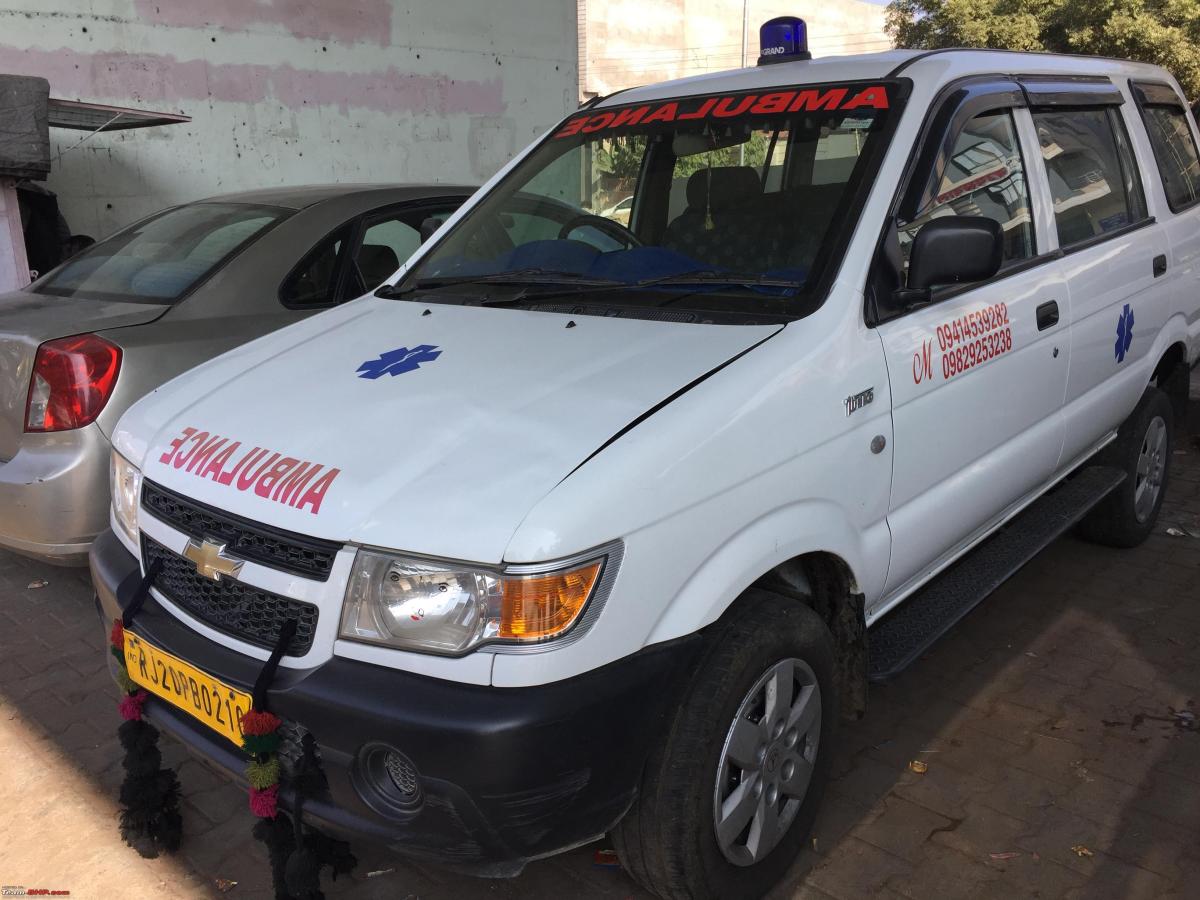
A Tavera ambulance is not as common as the ones listed above. However, I have seen a few hospitals using this vehicle. A hospital near my house in Bengaluru has a Tavera ambulance.
Maruti Gypsy

Lightweight and equipped with four-wheel, the Gypsy could be used on any terrain. It is used by the army, and even national parks. A Gypsy ambulance can be used in places with bad roads.
Mahindra Genio
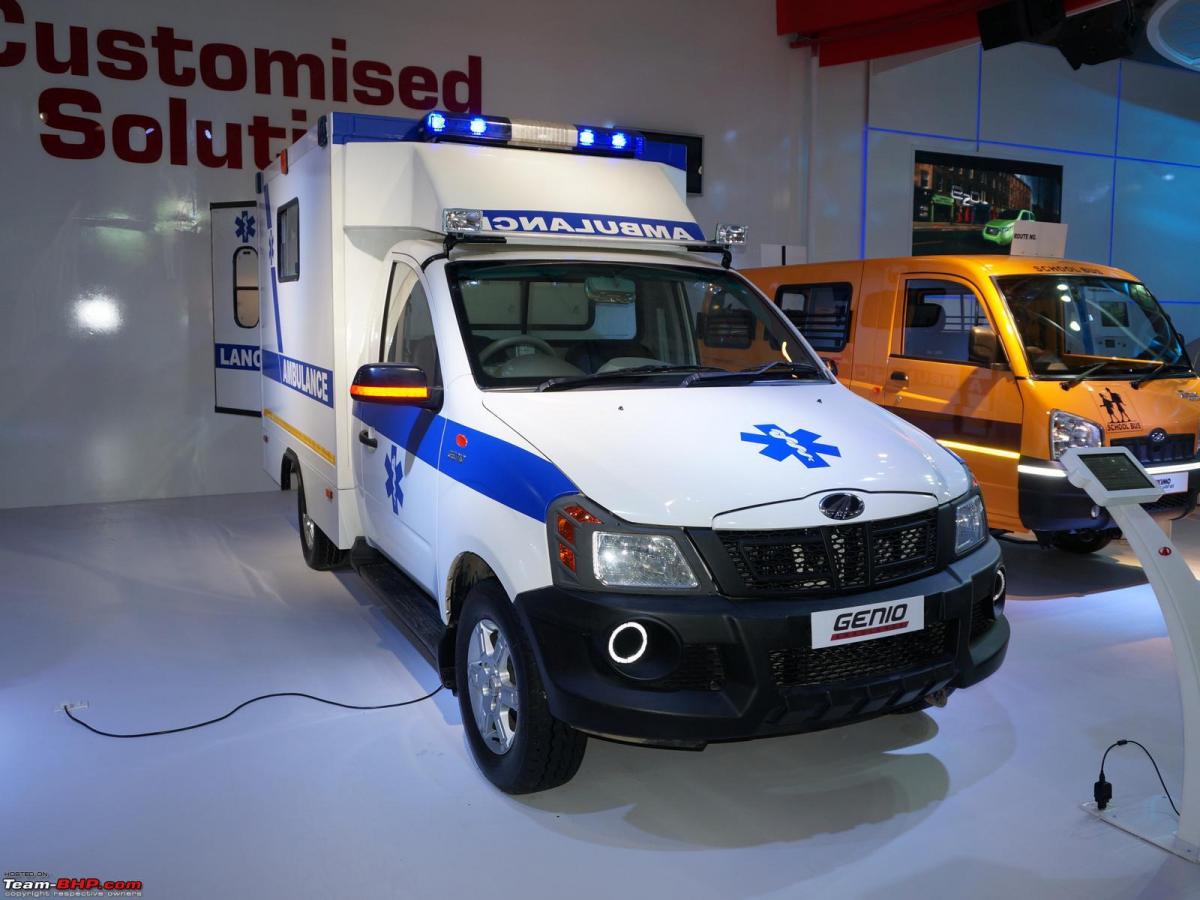
Mahindra built an ambulance based on the Genio, a pick-up truck based on the Xylo. It was available in two variants and came equipped with a rearview camera and an externally accessible oxygen tank.
Royal Enfield

Royal Enfield built an ambulance based on the Classic 350 motorcycle for the CRPF. The bike has been developed keeping in mind the specific needs of security personnel, especially those posted in Maoist zones. It is equipped to evacuate and attend to the injured.
Chevrolet Enjoy

The Enjoy is not a popular choice with ambulance operators. The vehicle has long been discontinued. Even when the MPV was on sale, it was not very popular.
Mahindra Bolero

The Bolero was India's best-selling SUV for a long time, thanks to its rugged appeal. Bolero ambulances are common in rural areas.
Mercedes-Benz W124

There are quite a few Mercedes W124s used as ambulances in India. Even the presidential convoy had a W124 ambulance, which was found abandoned and is now being restored.
MG Hector

MG converted one Hector to an ambulance for Covid-19 patients. It was donated to the CHC hospital in Halol, Gujarat.
Bajaj Avenger

Back in 2015, Bangalore got this "first responder" bike ambulance to reach the patients faster. The paramedics were trained to attend to the patients till a four-wheeled ambulance arrives.
ICML Extreme
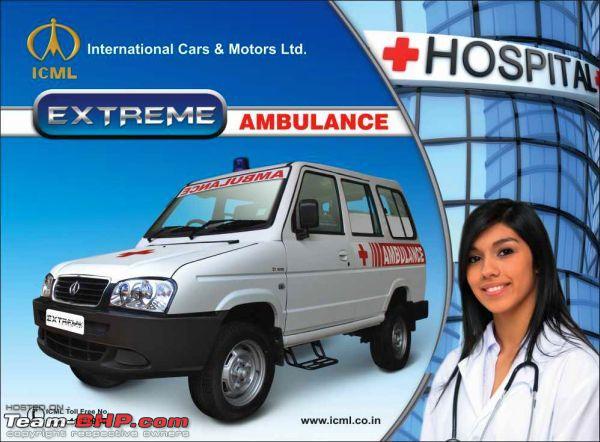
ICML launched an ambulance based on the Extreme MUV, which is a re-badged version of the Rhino. The ambulance is said to be engineered for reliability under trying weather and road conditions.
Polaris Ranger 6x6 800

Polaris teamed up with Bafne Healthcare to develop the Ranger 6X6 800. It is designed to ferry patients out of difficult terrains that are inaccessible for regular ambulances.
Hindustan Motors Oka

The Oka came out of a collaboration between Hindustan Motors and OKA Motor Company, Australia, to manufacture a Rough Terrain Vehicle (RTV). It was powered by a 2.0L Isuzu diesel engine and equipped with leaf spring suspension.
Hero Xtreme 200R

To help in the fight against the Covid-19 pandemic, Hero MotoCorp built a custom side-car bed for the Xtreme 200R. It is equipped with a full-stretcher with a foldable hood mounted on the side, essential medical equipment such as a detachable first-aid kit, oxygen cylinder, fire extinguisher and other safety features such as LED flasher lights, foldable beacon light, emergency wireless public announcement system, and siren.
Toyota Innova

Some hospitals used the Innova as an ambulance. Ambulance service providers need not worry about reliability if they have an Innova. However, I haven't seen many Innova Crysta ambulances. This is probably due of the high cost of the vehicle.
Ford F350

This well-equipped Ford F350 was imported into the country in June 2009 and was seen abandoned soon after. The ambulance is a completely self-sustaining mini-hospital. I am not sure of the condition of the vehicle now.
Mercedes Sprinter

Very few hospitals use(d) an imported Mercedes Sprinter as an ambulance. This one belonged to Apollo Hospitals in Bangalore.
Swaraj Mazda

Swaraj Mazda, now renamed as SML Isuzu, built ambulances which are used by hospitals as well as the Indian army.
Ashok Leyland Dost

The Dost is a small commercial vehicle launched in 2011. It has multiple applications and has even been used as an animal ambulance.
Force Trax

The Trax is a popular people carrier in rural India. The vehicle has lots of space on the inside making it a good candidate for an ambulance as well.
Tata Sumo

Along with some private hospitals and ambulance service providers, the Sumo has been used as an ambulance by the Indian army.
Nissan Jonga

The Jonga was a popular vehicle used by the Indian army. A few of them were used as ambulances as well.
1938 Dodge Ambulance

This one's from the British era. Kolkata's Tollygunge Club has this 1938 Dodge ambulance.
Volkswagen Microbus

The vehicle pictured here is a 1966 Volkswagen Microbus. It is said to be an original factory-supplied ambulance. One Microbus ambulance was also seen in a movie.
Citroen 2CV

This 1972 2CV was imported by St. Joseph's convent in Jolarpet, Tamil Nadu. It is used for medical camps in remote villages. It has a compartment with a sterilization box.
Air Ambulance
As their names suggest, a patient is transported by an aircraft. These are useful when a patient needs to be moved from one city to another, or from a remote area of the country into a metropolitan space. Air ambulances are most used in case of medical tourism - when a patient needs to be moved to another country for medical aid. They can be useful in multiple situations including a trauma scenario, mass disaster or any other medical emergencies.



